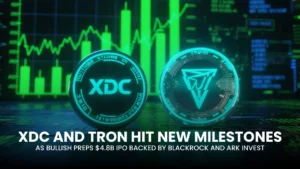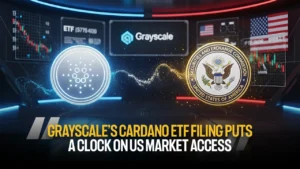TRON Whales Rise from Slumber as $100M TRX Deposited into Binance Without a Glitch

A significant on-chain transaction has drawn renewed attention to the TRON blockchain. On July 20, a wallet initiated a transfer of 150 million TRX tokens, with 99,999,999 TRX worth over $32 million ultimately deposited into Binance, one of the largest global cryptocurrency exchanges.
Though the motivation behind the move remains unclear, large transfers to centralized exchanges are typically monitored for potential liquidity movements or strategic fund reallocations.
Tracing the Path: From Wallet to Binance via HTX
The transaction originated from an unidentified wallet, which first sent 150 million TRX to HTX (formerly Huobi). From there, a near-round figure of 100 million TRX was forwarded to Binance in a single transaction. Such precise and sizable movements suggest coordination, though it’s uncertain whether the tokens are meant for trading, consolidation, or custody.
This scale of transfer is significant but not unusual for a network like TRON, which is designed to handle high-volume activity efficiently. Its performance is driven by a Delegated Proof of Stake consensus mechanism, allowing the network to process large amounts of data with minimal delay.
TRON’s Infrastructure Enables Scalable Movement
TRON’s design focuses on scalability and speed. At its core is the Delegated Proof of Stake protocol, which relies on a small group of elected validators to confirm transactions quickly. This approach allows the network to support high-throughput operations, such as the transfer of 100 million TRX tokens, without congestion.
DPoS enables this by removing bottlenecks common in older blockchain systems. For use cases that demand fast execution and volume like exchange transfers, stablecoin activity, and smart contract deployment, TRON has consistently demonstrated resilience under load.
Increased On-Chain Signals Across the Network
Beyond this single transaction, broader blockchain data reveals other important trends. TRX outflows from exchanges have totaled over $22 million recently, indicating ongoing accumulation. TRON has also seen stablecoin activity rise sharply, with USDT volume increasing by more than 90% week-over-week, with over 70% of the volume flowing through Binance.
ALSO READ: Cardano Passes Technical Review, Faces Call for Better Coordination
These signals reinforce the idea that TRON’s infrastructure, supported by DPoS, is handling not only routine transactions but also institutional-sized movements. Whether for trading or internal operations, such movements show confidence in the network’s underlying performance model.
Binance’s Central Role in TRX Liquidity Network
Binance remains one of the most active platforms for TRX-related assets. It facilitates the bulk of TRX trading volume, as well as a dominant share of TRON-based stablecoin transactions. The recent 100 million TRX deposit only reaffirms Binance’s role as a liquidity center for high-volume activity within the TRON ecosystem.
These transactions are made feasible in part because of the Delegated Proof of Stake model, which keeps TRON’s network flexible, cost-effective, and capable of routing large sums with speed and efficiency.
Conclusion
The movement of nearly 100 million TRX to Binance marks one of the largest single-token transfers on the TRON network in recent history. While the reason for the transfer remains unknown, the event highlights TRX’s growing on-chain activity and the strength of its DPoS-based infrastructure in handling high-capacity transactions. As TRX’s role in stablecoins and cross-platform liquidity grows, more eyes are likely to follow these kinds of strategic transfers across the blockchain.
Frequently Asked Questions (FAQs)
Who transferred the 100 million TRX?
The wallet address is unknown. The tokens were sent first to HTX, then moved to Binance.
Was this meant for a sale or trade?
There’s no official confirmation. The transfer alone does not indicate trading activity.
Why is Binance relevant to this event?
Binance is the largest exchange handling TRX and TRON-based stablecoins. It processes most of the network’s volume.
How can TRX handle such a large transfer smoothly?
The network operates on a DPoS model, allowing fast and scalable transaction processing.
Does this kind of movement happen often?
High-value transfers are not unusual for TRX, especially as stablecoin use and exchange volume continue to grow.
Glossary of Key Terms
TRON (TRX):
A blockchain-based decentralized platform that aims to build a free, global digital content entertainment system. TRX is its native token.
TRX Transfer:
A blockchain transaction involving the movement of TRX tokens between wallets or exchanges.
Binance:
The world’s largest cryptocurrency exchange by trading volume, frequently used for TRX and stablecoin transactions within the TRON ecosystem.
HTX (formerly Huobi):
A centralized cryptocurrency exchange that temporarily received the initial 150 million TRX before 100 million was forwarded to Binance.
Delegated Proof of Stake (DPoS):
A consensus mechanism used by TRON where token holders vote to elect a small number of validators, enabling faster and more scalable transaction processing.
On-chain Transaction:
A transaction recorded directly on the blockchain network, visible and verifiable in real-time via block explorers.
Stablecoin Volume:
The total value of transactions using stablecoins like USDT. On TRON, stablecoin activity is a key indicator of liquidity and utility.
Liquidity Movement:
The transfer of assets (like TRX) to or from exchanges, often signaling trading activity, fund management, or reallocation strategies.
Blockchain Scalability:
The ability of a blockchain network to handle an increasing number of transactions without compromising speed or performance.
Whale Activity:
Large-scale movements of tokens (usually in the millions) are often conducted by institutions or high-net-worth individuals, which can influence market behavior.




